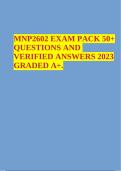MNP2602 EXAM PACK 50+
QUESTIONS AND
VERIFIED ANSWERS 2023
GRADED A+.
,Key Definitions: MCQs
1. Define the term ‘logistics management’.
• The part of supply chain management that plans, implements and controls the
efficient and effective forward and reverse flow and storage of goods, services
and related information between the point of origin and the point of consumption
to meet customers’ requirements. It includes inbound, outbound, internal and
external movements, and is relevant in both manufacturing and service
organisations and in both private and public-sector organisations.
2. Define the term strategic sourcing from both abroad and a narrow sense
a) In a broad sense, strategic sourcing is all the issues that are of strategic
importance in the supply of materials and services to a modern organisation.
b) In a narrow sense, strategic sourcing is the strategic management process
whereby commodities (materials and services) and suppliers are analysed, and
relationships are formed and managed according to best practices and
appropriate strategies in support of long-term organisational goals.
3. Define the term value chain
a) The value chain (developed by Michael Porter) comprises primary and support
activities that can lead to a competitive advantage for an organisation when they
are configured properly. The value chain is also seen as a management
philosophy.
b) Explanatory notes on the term "value chain":
i. Primary activities include inbound logistics, operations, outbound
logistics, marketing and sales, and customer service.
ii. Support activities include purchasing, human resources management,
technological development and infrastructure.
4. Define distribution management
a) Distribution management entails managing downstream processes (or outbound
logistics) and activities to deliver and thus physically distribute the product or
service from the end of the production line to the ultimate (or end) customer.
5. What is the main difference between a supply chain and a value chain?
A. [1] A supply chain is focused on the supply activity, whereas the value chain is
focuses on value-adding activities.
B. [2] A supply chain has different upstream and downstream linkages, whereas the
value chain has only downstream linkages.
C. [3] A supply chain consists of the value-adding activities of a network of
organisations, whereas a value chain consists of the value-adding activities of a
specific organisation.
, D. [4] A supply chain focuses its activities on satisfying the final consumer ’s need,
whereas a value chain coordinates the supply chain activities of different supply chain
role players.
6. In a typical supply chain, an upstream linkage will be on the … side of the supply chain.
a) A. [1] supplier
b) B. [2] end consumer
c) C. [3] focal firm
d) D. [4] outbound
Learning Unit 2 - Chapter 2: Essay
7. Explain how an organisation like BMW would use the purchasing process to purchase raw
materials from their suppliers.
The purchasing process starts when the material user initiates a request for a material by
issuing a material requisition form. On the form the product, quantity and delivery due
date are clearly described. A copy of the requisition will be sent to the warehouse for
delivery and a copy is sent to the accounts department for the necessary invoicing to be
done. A Bill of Materials is also sometimes used by certain companies to order materials.
In certain cases, the requested material may be out of stock, in these cases the materials
requisition will be sent to the purchasing department or the firm will let know the buyer of
an alternative product available. If BMW has no current supplier of an item or would like
to change suppliers, a Request for quotation may be issued to a supplier. This form will
outline the product that is required and quantity in which it is required. Once a suitable
supplier will be found a purchase order will be issued to the selected suppliers. An
original and a copy of the order will be sent to supplier
8. Define centralised and decentralised purchasing (4)
Centralised Purchasing – A single purchasing department, usually located at the firm’s
corporate office, makes all the purchasing decisions for the entire corporations (2)
Decentralised Purchasing – A system where individual, local purchasing departments
such as at the plant or field-office level, make their own purchasing decisions (2)
9. Under which conditions would you most likely utilize a centralized purchasing system?
A centralized purchasing system would be favored by a company that is looking to reduce
safety stocks, increase control in purchasing, centralize decision making, avoid duplicate
purchases, centrally manage supplier relationships, and maximize available quantity
discounts.
List two advantages that would be gained by utilizing a centralized purchasing system.
a. Concentration of purchasing leading to lower purchase costs




